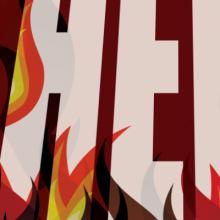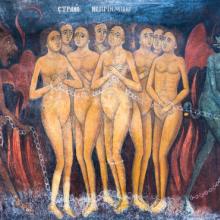sheol
I GREW UP IN THE BAPTIST CHURCH, memorizing scripture as part of our “sword drills” and arming myself with the necessary tools to convert my friends to the side of righteousness. I was taught that the Earth was 5,000 years old, that scientists fabricated the fossil record to fit their agenda, and that some people—really, most people—were going to hell.
I remember waking up, shaking in my bed from dreams of the hungry flames of hell licking at my heels. My daily decisions were increasingly governed by fear and guilt rather than by love or a sense of what was right.
Where do our contemporary ideas about hell come from? First, we have to consider what it is we’re talking about when we say “hell.” Is it effectively the same as the annihilation of the soul, when one ceases to exist, even in the spiritual sense? Is it less physical and more of a conscious torment, where we, bound by our sins, spend eternity aware only of our irreconcilable separation from God?
Blue Like Jazz author Donald Miller says, “If the religious fundamentalists are right, heaven will be hell. And almost nobody will be there.” Rob Bell, best known for his bestselling book Love Wins, stirred up a tidal wave of controversy not so much for suggesting there wasn’t a hell, but for suggesting a loving God would ensure that such a place would sit empty.
IN THE OLD TESTAMENT, the word “hell” appears 31 times. The phrase “the grave” is used 31 times, and “the pit” comes in at a distant third with three appearances. But all 65 instances of these words throughout the first 39 books of the Bible come from the same Hebrew word, Sheol.
In the Jewish tradition, Sheol is a resting place for the dead. While some believe this is the same as hell, there are indications to the contrary. In the ancient Jewish tradition, Sheol is a place of rest for both righteous and wicked, with no distinction.
Yesterday, I discussed some of the historical bases for our contemporary understanding of Satan. Today, I’ll consider how hell evolved as part of the Christian faith.
In Old Testament scripture, the resting place for the dead is called Sheol. While some believe this is the same as hell, there are indications to the contrary. In the ancient Jewish tradition, Sheol is a place of rest for both righteous and wicked, with no distinction.
Not everyone is happy about it either.
In the third chapter of Malachi, the prophet recognizes the consternation of faithful Jews who are frustrated that the wicked share the same fate. In Ecclesiastes, the priest Koheleth claims that serving God is vanity. For him, the fact that the righteous are treated the same as the wicked and vice-versa should be a call to eat, drink and be merry.
With respect to any relationship between Satan in the Old Testament and Sheol, there is none.

